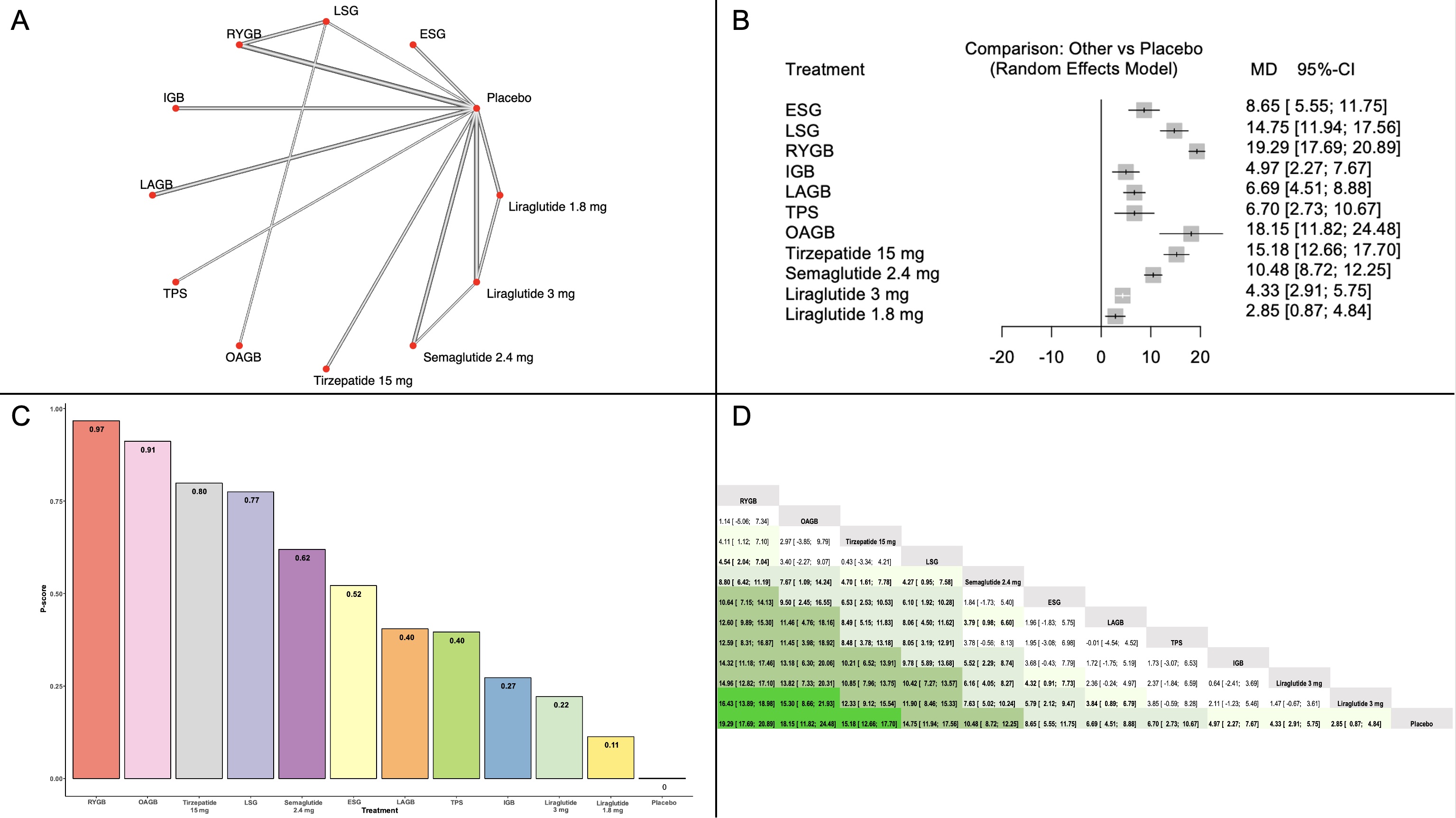Oral Paper Presentation
Annual Scientific Meeting
Session: Plenary Session 3B - Obesity / Biliary-Pancreas
46 - Comparative Efficacy and Safety of Bariatric Surgery, Bariatric Endoscopy, and GLP-1 Receptor Agonists in Obesity Management: A Network Meta-Analysis
Tuesday, October 29, 2024
2:15 PM - 2:25 PM ET
Location: Terrace Ballroom 2-3

Jena Velji-Ibrahim, MD, MSc (she/her/hers)
Prisma Health-Upstate/University of South Carolina School of Medicine
Greenville, SC
Presenting Author(s)
Jena Velji-Ibrahim, MD, MSc1, Dhruvil Radadiya, MD2, Kalpit Devani, MD1
1Prisma Health-Upstate/University of South Carolina School of Medicine, Greenville, SC; 2Kansas University Medical Center, Kansas City, KS
Introduction: Although bariatric surgery effectively manages obesity, it carries risks of perioperative mortality and long-term complications. Bariatric endoscopy offers a minimally invasive option and GLP-1 receptor agonists (GLP-1 RAs) show promise. A comprehensive review encompassing bariatric surgery, bariatric endoscopy, and GLP-1 RAs for obesity management is lacking.
Methods: We systematically searched electronic databases for randomized controlled trials (RCTs) comparing the efficacy of FDA-approved bariatric surgeries, bariatric endoscopies, and GLP-1 RAs in adults. The primary outcome was percentage total weight loss (%TWL). Secondary outcomes included improvement in obesity-related comorbidities and side effect profiles. A network meta-analysis using frequentist methods with a random-effects model was conducted. We calculated p-scores to rank treatments and identify the preferred intervention. A league table provided network estimates.
Results: 34 RCTs comprising 15,660 adults with BMI 25-45 were included in this network meta-analysis. We included 4 bariatric surgeries, 3 bariatric endoscopies, and 4 GLP-1 RAs (Fig 1A). On network comparison, all interventions were associated with a reduction in %TWL compared to placebo. While RYGB led to the most weight loss (19.29%, Fig 1B) and was the first-ranked treatment at a probability of 97% (Fig 1C), tirzepatide 15 mg produced nearly similar weight loss (15.18%, Fig 1B). There was no significant difference in %TWL between OAGB and tirzepatide 15 mg (MD 2.97%; 95% CI -3.85% to 9.79%) or LSG and tirzepatide 15 mg (MD 0.43%; 95% CI -3.34% to 4.21%, Fig 1D). There was also no significant difference in %TBWL between semaglutide 2.4 mg with ESG and TPS. Weight loss >5% was achieved with ESG, TPS, and IGB. Bariatric endoscopy had a better side effect profile compared to bariatric surgery in terms of odds of mortality and intensive care needs. Gastrointestinal issues were the most common side effects of GLP-1 RAs. Comparison-adjusted funnel plot did not show publication bias (egger’s test p =0.7877).
Discussion: This is the first meta-analysis to compare bariatric surgery, endoscopy, and GLP-1 RAs for obesity management. Tirzepatide 15 mg has emerged as a promising option for its weight loss efficacy and safety profile compared to bariatric surgery. ESG and TPS offer minimally invasive alternatives with good outcomes and fewer adverse effects. Further research should explore long-term outcomes and combination therapies to optimize obesity treatment.

Disclosures:
Jena Velji-Ibrahim, MD, MSc1, Dhruvil Radadiya, MD2, Kalpit Devani, MD1, 46, Comparative Efficacy and Safety of Bariatric Surgery, Bariatric Endoscopy, and GLP-1 Receptor Agonists in Obesity Management: A Network Meta-Analysis, ACG 2024 Annual Scientific Meeting Abstracts. Philadelphia, PA: American College of Gastroenterology.
1Prisma Health-Upstate/University of South Carolina School of Medicine, Greenville, SC; 2Kansas University Medical Center, Kansas City, KS
Introduction: Although bariatric surgery effectively manages obesity, it carries risks of perioperative mortality and long-term complications. Bariatric endoscopy offers a minimally invasive option and GLP-1 receptor agonists (GLP-1 RAs) show promise. A comprehensive review encompassing bariatric surgery, bariatric endoscopy, and GLP-1 RAs for obesity management is lacking.
Methods: We systematically searched electronic databases for randomized controlled trials (RCTs) comparing the efficacy of FDA-approved bariatric surgeries, bariatric endoscopies, and GLP-1 RAs in adults. The primary outcome was percentage total weight loss (%TWL). Secondary outcomes included improvement in obesity-related comorbidities and side effect profiles. A network meta-analysis using frequentist methods with a random-effects model was conducted. We calculated p-scores to rank treatments and identify the preferred intervention. A league table provided network estimates.
Results: 34 RCTs comprising 15,660 adults with BMI 25-45 were included in this network meta-analysis. We included 4 bariatric surgeries, 3 bariatric endoscopies, and 4 GLP-1 RAs (Fig 1A). On network comparison, all interventions were associated with a reduction in %TWL compared to placebo. While RYGB led to the most weight loss (19.29%, Fig 1B) and was the first-ranked treatment at a probability of 97% (Fig 1C), tirzepatide 15 mg produced nearly similar weight loss (15.18%, Fig 1B). There was no significant difference in %TWL between OAGB and tirzepatide 15 mg (MD 2.97%; 95% CI -3.85% to 9.79%) or LSG and tirzepatide 15 mg (MD 0.43%; 95% CI -3.34% to 4.21%, Fig 1D). There was also no significant difference in %TBWL between semaglutide 2.4 mg with ESG and TPS. Weight loss >5% was achieved with ESG, TPS, and IGB. Bariatric endoscopy had a better side effect profile compared to bariatric surgery in terms of odds of mortality and intensive care needs. Gastrointestinal issues were the most common side effects of GLP-1 RAs. Comparison-adjusted funnel plot did not show publication bias (egger’s test p =0.7877).
Discussion: This is the first meta-analysis to compare bariatric surgery, endoscopy, and GLP-1 RAs for obesity management. Tirzepatide 15 mg has emerged as a promising option for its weight loss efficacy and safety profile compared to bariatric surgery. ESG and TPS offer minimally invasive alternatives with good outcomes and fewer adverse effects. Further research should explore long-term outcomes and combination therapies to optimize obesity treatment.

Figure: Figure 1. Comparison of weight reduction among bariatric surgeries, bariatric endoscopies, and GLP-1 RAs. 1A exhibits the network graph with 11 different interventions, excluding placebo. 1B illustrates a forest plot with network comparison using a random effects model. 1C contains a rankogram which identifies the preferred intervention to achieve maximum %TWL. 1D displays the league table of indirect comparisons of %TWL by intervention.
Disclosures:
Jena Velji-Ibrahim indicated no relevant financial relationships.
Dhruvil Radadiya indicated no relevant financial relationships.
Kalpit Devani indicated no relevant financial relationships.
Jena Velji-Ibrahim, MD, MSc1, Dhruvil Radadiya, MD2, Kalpit Devani, MD1, 46, Comparative Efficacy and Safety of Bariatric Surgery, Bariatric Endoscopy, and GLP-1 Receptor Agonists in Obesity Management: A Network Meta-Analysis, ACG 2024 Annual Scientific Meeting Abstracts. Philadelphia, PA: American College of Gastroenterology.


